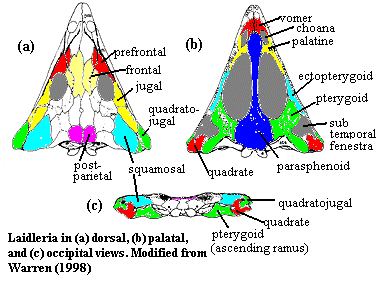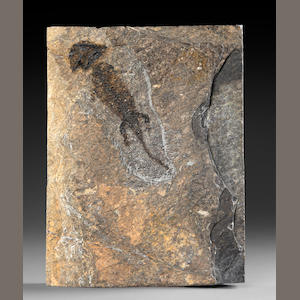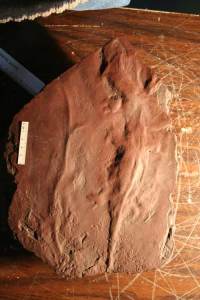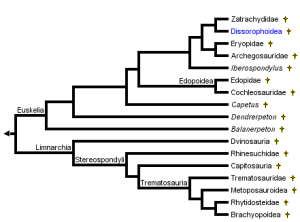LIJST L Fossiele AMFIBIEEN
juni 16, 2013 4 reacties
°
GLOS A INHOUD GLOS A →
L
A B C D E F G H I J K L M N O P Q R S T U V W X Y Z

Cross-section of a labyrinthodont tooth
 Labyrinthodont tooth/Author: Moya Meredith Smith/Sources: Parc national de Miguasha// 1996Cross-section through a tooth from Eusthenopteron foordi. The labyrinth pattern of infolded dentine inside the tooth is a characteristic feature shared by the first tetrapods.http://www.miguasha.ca/mig-en/eusthenopteron.php
Labyrinthodont tooth/Author: Moya Meredith Smith/Sources: Parc national de Miguasha// 1996Cross-section through a tooth from Eusthenopteron foordi. The labyrinth pattern of infolded dentine inside the tooth is a characteristic feature shared by the first tetrapods.http://www.miguasha.ca/mig-en/eusthenopteron.php
http://nl.wikipedia.org/wiki/Labyrinthodontia http://en.wikipedia.org/wiki/Labyrinthodontia
De eerste amfibieën waren labyrinthodonten, zij waren de eerste gewervelde dieren die het land op trokken. Hun experiment duurde 160 miljoen jaar, van het Laat-Devoon tot in de vroege Jura. Het was een gedeeltelijk succes. Tijdens de hoogtijperiode in het Vroeg-Perm waren zes van de tien labyrinthodonten volledig aan het leven op het land aangepaste insekteneters. Hierna zette het verval in en aan het eind van de Trias waren ze alle uitgestorven. De labyrinthodonten danken hun naam aan de labyrintvormige plooiing van het tandbeen in hun kegelvormige tanden. Deze tanden lijken sterk op de tanden van de rhipidiste, spiervinnige vissen. Dit en nog een aantal ander skeletkenmerken hebben paleontologen tot de overtuiging gebracht dat de amfibieën van deze spiervinnige vissen afstammen. De Labyrinthodontia worden opgesplitst in twee goed afgebakende orden – de Temnospondyli en de Anthracosauria. Een derde orde, de Ichthyostegalia – de eerste amfibieën – zijn volgens sommige paleontologen primitieve temnospondylen.
Labyrinthodontia incertae sedis
(by Neal Robbins) Laccocephalus was a prehistoric amphibian of the Rhinesuchidae family. Fossils of it have been found in the Daptocephalus Zone of the Beaufort beds in the Orange Free State of South Africa. There is some debate about when this creature existed. Carroll said that it lived during the Induan, i.e. the first subperiod of the Triassic. However, Anderson and Cruikshank insist that it was of the late part of the Permian period.
P.S. Laccocephalus was in the same family as these genera:
Broomistega
Uranocentrodon
Rhinesuchus
http://palaeos.com/vertebrates/temnospondyli/stereospondyli.html
Range: Late Permian or Early Triassic of South Africa.
Phylogeny: Rhinesuchidae: Rhinesuchus + Uranocentradon + Broomistega + *.
Laccocephalus Watson.
Horizon: Daptocephalus zone, Beaufort Beds, Orange Free State, South Africa
Age: ? Changhsingian
Place: central Gondwana
Comments: previously included with Uranocentradon in the family Uranocentrodontidae. Carroll lists this genus as early Triassic, but according to Anderson & Cruikshank (1978) it is late Permian. Perhaps it is from the early Changhsingian. (MAK 010423).
Laccosaurus is an extinct genus of prehistoric amphibian.
http://www.palaeocritti.com/by-group/lissamphibia/laccotriton
Salamander Lissamphibia Caudata Urodela

Holotype fossil (GMV 1602) of Laccotriton subsolanus. From Gao & Shubin, 2001.
http://palaeos.com/vertebrates/temnospondyli/plagiosauroidea.html


Lapillopsis nana
This genus is from Arcadia Formation of Queensland. The description of this genus is based on many small skulls less than 2 cm long. Superficially it resembles micropholids. They lacked sensory-line grooves and had a long-stemmed interclavicle bone beneath the shoulder region. Both these features indicate that Lapillopsis was more adapted for life on land than any other Triassic temnospondyls from the Arcadia Formation.
Some of the diagnostic features of this genus are long jugal bones extending in front of the eyes. There are well-developed tabular horns and large orbits. The latter feature are probably features of immature animals. Sensory-line canals were not well developed. Some think Lapillopsis is closely related to Micropholis from Germany. Others disagree that it is closely related to the dissorophopids, believing it is more closely related to stereospondyls.
Sources & Further reading John A Long, Dinosaurs of Australia and New Zealand, University of New South Wales Press
°
- “Latiscopus” —> syn : Almasauridae was named by Dutuit (1972).
-
Latiscopus disjunctus —>
It was assigned to Almasauroidea by Carroll (1988); and to Trematosauroidea by Schoch and Milner (2000).
- Labyrinthodontia – Zittel, 1888
- Suborder: Trematosauria – Yates & Warren, 2000
- Superfamily: Trematosauroidea
- Family: Trematosauridae
- Genus: Latiscopus
- Specific name: disjunctus
- Scientific name: – Latiscopus disjunctus
- Specific name: disjunctus
- Genus: Latiscopus
- Family: Trematosauridae
- Superfamily: Trematosauroidea
- Suborder: Trematosauria – Yates & Warren, 2000
-
Leterpeton austriacum
Permian
Czech Republic
Letoverpeton lived before the dinosaurs in the Early to Middle Permian. Little is known of these primitive amphibians, which are extremely rare members of the Discosauriscidae family.
Name: Amphibia: Urodela; Liaoxitriton zhongjiani Age: Lower Cretaceous, (~125 m.y.a.) Size (25.4 mm = 1 inch): 110 mm long (tip of skull to tip of tail along backbone). Matrix: 296 mm by 60 mm Location: Huludao City, Jiufotang Formation, Liaoning Province of China

Description: This is a fine positive/negative pair of a rarely seen amphibian; a salamander known as Liaoxitriton zhongjiani. . The species takes its generic name from Liaoxi, the general region from which the specimen comes, while the specific name is for the researcher who first discovered this specimen. The detail is incredible; even more remains to be uncovered (see some of the bones of the forearm). Even a 20 mm partial tail of another unknown vertebrate is present.
Phyletogentic analysis of the Urodeles shows that Asia is the origin of the clade, leading to the hypothesis that the basal salamanders radiated from the region. Some salamanders demonstrate neoteny, or the capability of reproducing while in what is apparently the larval state. Note the soft tissue outlines preserved, and what appears to be gill structures, a telltale that this is not a larval form but a neotenic example.
Neoteny is not all that uncommon among modern-day salamanders (some 40 species in 9 different families demonstrate this strategy), with the Mexican Salamander or Axolotl being a prime example. This means that it retains its gills and fins, and it doesn’t develop the protruding eyes, eyelids and characteristics of other adult salamanders. It grows much larger than a normal larval salamander, and it reaches sexual maturity in this larval stage.
The independent occurrence of neoteny in both Mesozoic and recent groups of salamanders makes parallel evolution of numerous morphological features an enduring feature of their history. An example such as this of the first salamander to be discovered from the Mesozoic in the east Asian region
- Limnerpeton
- Limnoiketes
- Limnogyrinus
- Lisserpeton
- Lithobatrachus
- Llankibatrachus
- Llistrofus
- Longiscitula
- Luzocephalus
- Lydekkerina
- Lyrocephaliscus
- Lysorophus
M
A B C D E F G H I J K L M N O P Q R S T U V W X Y Z
Ces vertébres sont plates et peuvent appatenir à Metoposaurus.
Grosse dent peut être Metoposaurus ? dans tous les cas un animal de plus de 2 m.
(ce crâne de Metoposaurus diagnosticus a été découvert en Pologne a Krasiejowa)
http://fosillia-vosgiensis.over-blog.com/article-35791401.html

Long bone histology of Metoposaurus diagnosticus (Temnospondyli) from the Late Triassic of Krasiejów (Poland) and its paleobiological implications
http://www.tandfonline.com/toc/ujvp20/current#.Unl_SaAVHcf
This image shows microanatomy of the midshaft of Metoposaurus femur. Credit: Photo by Georg Oleschinski
This is the femur of Metoposaurus diagnosticus krasiejowensis as viewed from behind (posterior). The sectioned plane is marked by the white stripe. Credit: Photo by Georg Oleschinski.
Read more at: http://phys.org/news/2013-09-giant-triassic-amphibian-burrowing-youngster.html#jCp

Metoposaurus diagnosticus weighed half a tonne and was 10 feet long, but its environment had only two seasons: wet and dry. It needed water for its lifestyle, but researchers have discovered the extremely long dry season 230 million drove the species to burrow underground and go dormant
The burrowing behaviour of Metoposaurus was recently discovered by Dorota Konietzko-Meier, of the University of Opole in Poland and the University of Bonn in Germany, and Martin Sander, also of the University of Bonn.

The study examined a cross-sections of Metoposaurus bones which have growth rings, called annuli. The above image shows annuli in femur samples of metoposaurus diagnosticus. A thick inner phase of fast growth is marked by zI and a broad phase of slow growth can be seen in the middle left image (a1)

The broad, flat head broad flat arm bones, wide hands, and large tail of Metaposaurus diagnosticus led the investigators to conclude that this species swam in lakes during the wet season

Dr Michel Lauri, from the Musium National d’Histoire Naturelle said: ‘This animal was much larger than any extant burrowing species I know of, and if it dug, I suspect that the snout (pictured) and tail played a far greater role than the limbs, as we observe in most extant aquatic vertebrates’
The Metoposaurus diagnosticus was thought to be a mostly aquatic animal. It had small limbs, sharp teeth and a large flat head. Its diet was mainly fish which it captured with its wide jaws lined.
Metoposaurus could reach up to 3m (10 feet) long, weighed 454 kg and was one of the last large amphibians.
Many Metoposaurus mass graves have been found. Researchers believe this was probably from creatures that grouped together in drying pools during drought.
Read more: http://www.dailymail.co.uk/sciencetech/article-2408926/Prehistoric-amphibian-weighing-half-tonne-burrowed-underground-survive-extreme-droughts-230-million-years-ago.html#ixzz2jojuCuj3
partial skull of the amphibian Metoposaurus diagnosticus krasiejowensis
leg bone of Metoposaurus diagnosticus krasiejowensis
part of the armour of Metoposaurus diagnosticus krasiejowensis
skull of Metoposaurus diagnosticus krasiejowensis
http://www.discussfossils.com/forum/printer_friendly_posts.asp?TID=615



Micromelerpeton was een amfibie die in het Onder-Perm leefde in wat nu zuidwest-Duitsland is. Hij behoorde tot de Branchiosauriërs: volwassen amfibieën met de kenmerken van larven, zoals uitwendige kieuwen en niet-verbeende elementen in de pols en enkel. Micromelerpeton kon maximaal 20 cm lang worden. In het Onder-Perm lag Duitsland veel zuidelijker dan tegenwoordig. De gemiddelde temperatuur was tropisch en het klimaat vochtig, ideaal voor amfibieën. De voornaamste vijanden van Micromelerpeton waren vooral Sclerocephalus en zoetwaterhaaien zoals Orthacanthus.
http://www.henskensfossils.nl/NETH0001.htm
Micromelerpeton from the Permian of Germany with Skin Preservation
6” long amphibian Micromelerpeton Credneri is over 260 million years old from Odenhein, Germany. . Micromelerpeton still probably spent much of its time in water close to the shallow sea bottom.
What makes this specimen so exceptional is its state of preservation. It is virtually complete with the exception of a few hand and foot bones. The 1” arrow shaped skull is complete with even patches of its ornamental skin preserved. The body and tail is covered with carbonized skin impressions some even preserving the texture of the skin. As a bonus there are also two partial amphibians also present on the same 13” x 8” stone slab. The 3” partial also has carbonized skin and is nearly complete missing only its head and 3 legs. The two small jaws with sharp teeth are present near the top of the slab. This is a remarkably detailed and important fossil.
- Order Microsauria. A large group (at least 30 genera) from Carboniferous and Early Permian North America and Europe of mainly terrestrial amphibians, that are characterized by the reduced number of bones in the skull and the occiput-atlas complex. They show some evolution towards a burrowing life style. Two examples of microsaurs are Tuditanus from Ohio, USA, which had lizard-like proportions and Microbrachis from the Czech republic, which is thought to have become secondarily aquatic.
 Reconstruction of (a) Tuditanus and (b) Microbrachis, from Benton, 1997
Reconstruction of (a) Tuditanus and (b) Microbrachis, from Benton, 1997
- Miopelobates
- Miopelodytes
- Mioproteus
- Molgophis
- Monsechobatrachus
- Montcellia
- Mordex
- Muchocephalus
- Mynbulakia
[edit]N
| Contents: | A B C D E F G H I J K L M N O P Q R S T U V W X Y Z |
|---|
- Order Nectridea. A group of aquatic early amphibians from the Late Carboniferous to the Early Permian. Many were newt-like in appearance with long flat tails for swimming, such as Sauropleura from Late Carboniferous Europe and North America. Interesting members of this order are Diplocaulus and Diploceraspis from the Late Carboniferous and Early Permian of the USA, which have expanded skulls with large horns growing out of the sides. The juvenile forms have no horns at all and they enlarge throughout life. The function of the horns is still not understood.
O
A B C D E F G H I J K L M N O P Q R S T U V W X Y Z
- Odenwaldia
- Odonterpeton
- Odontosaurus
- Oestocephalus
- Oligosemia
- Onchiodon
- Ophiderpeton
- Opisthotriton
- Orthophyia
- Osteophorus
- Ostodolepis
[edit]P
| Contents: | A B C D E F G H I J K L M N O P Q R S T U V W X Y Z |
|---|
- Pachybatrachus
- Pachygonia
- Palaeobatrachus
- Palaeomolgophis
- Palaeopleurodeles
- Palaeoproteus
- Paleoamphiuma
- Panchetosaurus
- Pangerpeton
- Pantylus
Pantylus


The only known example of Paracyclotosaurus davidi,an amphibian that lived in Australia around 235 million years ago.The type specimen of Paracyclotosaurus is the only example of a complete articulated skeleton of a capitosaur, one of the major groups of Triassic temnospondyl amphibians.
NHM
- Paradiscoglossus
- Paralatonia
- Pariotichus
- Parioxes
- Parotosaurus
- Parrisia
- Pasawioops
- Pelodosotis
- Pelorocephalus
- Pelophilus
- Peltobatrachus
- Peltostega
- Peratosauroides
- Peronedon
- Phlegethontia Phlegethontia, an aistopod from the Pennsylvanian.

PLAGIOSAUROIDEA (Abel, 1919)
Les vertébres ont un centra cylindrique. Sur la face dorsale on peut observer une rainure centrale bordée par les facettes d’insertions des arcs neuraux.


Ces vertébres peuvent appartenir à Plagiosaurus ou a Gerrothorax deux animaux aux crânes particuliers
- Plagioscutum
- Plagiosternum
- Plagiosuchus
- Platycepsion
- Platyhystrix
- Platyoposaurus
- Platyrhinops
- Platystega
- Plemmyradytes
- Pleuroptyx
- Pliobatrachus
- Pneumatostega
- Prionosuchus
- Proamphiuma
- Procerobatrachus
- Procochleosaurus
- Procynops
- Prodesmodon
- Prodiscoglossus
- Promastodonsaurus
- Propelodytes
- Prosalirus
- Prosiren
- Proterogyrinus
- Prothoosuchus
- Pseudophlegethontia
- Ptychosphenodon
- Ptyonius
- Putterillia
[edit]Q
| Contents: | A B C D E F G H I J K L M N O P Q R S T U V W X Y Z |
|---|
[edit]R
| Contents: | A B C D E F G H I J K L M N O P Q R S T U V W X Y Z |
|---|
Roodgekleurd merg ontdekt in fossielen Spaans amfibieën

Tien miljoen jaar oud beenmerg is ontdekt in fossiele kikkers (Rana pueyoi) en salamanders (Triton) die zijn gevonden in het noordoosten van Spanje.
Volgens een team van Spaanse en Ierse wetenschappers is het beenmerg (weefsel aan de binnenkant van grote botten waar de meeste bloedcellen worden aangemaakt) bewaard gebleven in zijn oorspronkelijke toestand. Zelfs de oorspronkelijke rode kleur is nog te zien. (Geology, augustus 2006).
De ontdekking is een nieuwe aanwijzing dat kwetsbare, zachte weefsels in fossielen beter bewaard kunnen blijven dan lang is aangenomen. Voor wetenschappers is dat van belang omdat uit deze weefsels sporen van DNA en zelfs de eiwitten van dieren gewonnen kunnen worden.
Paleontologe Mary Schweitzer van de Universiteit van Montana publiceerde vorig jaar in Science over de ontdekking in beenderen van Tyrannosaurus rex van collageen, bloedvaten en mogelijk zelfs bloedcellen. Over het mechanisme waardoor deze weefsels 65 miljoen jaar behouden bleven, heeft zij nog niet gepubliceerd.
In hun studie over salamanders en kikkers opperen Maria McNamara van University College Dublin en haar collega’s dat het beenmerg beschermd is gebleven tegen bacteriën en andere schadelijke chemische processen door een laag omringend bot. Omdat de weefsels van de salamanders en die van T. rex zijn ontdekt in milieus die sterk verschillen (respectievelijk kleisteen en zandsteen) achten de onderzoekers het waarschijnlijk dat de conservering van kwetsbare weefsels in fossielen veel algemener is dan tot nu toe is aangenomen.
In het Libros-bekken, een bekende fossiele vindplaats in Spanje, onderzochten McNamara en haar collega’s 15 volwassen salamanders en 56 volwassen kikkers. Uit zes van de kikkers en één salamander konden de onderzoekers beenmerg halen met een pincet. Omdat dit alleen mogelijk was op plaatsten waar de fossiele botten gebroken waren, veronderstellen zij dat in werkelijkheid een groter percentage van de fossielen beenmerg bevat.
- Rileymillerus
- Rewana
- Rhadalognathus
- Rhadinosteus
- Rhineceps
- Rhinesuchoides
- Rhinesuchus
- Rhinophrynus
- Rhynchonkos
- Rhytidosteus
- Ricnodon
- Rotaurisaurus
- Rubricacaecilia
[edit]S
| Contents: | A B C D E F G H I J K L M N O P Q R S T U V W X Y Z |
|---|

Reconstruction of Sauropleura, from Benton, 1997.
Sclerocephalus haeuseri,



Sclerocephalus was een salamander (een amfibie dus) die ongeveer 280 miljoen jaar geleden (in het Onder-Perm) in wat nu zuidwest-Duitsland is leefde. Hij leefde in zoetwatermeren en was met zijn maximale lengte van 2 m één van de grootste amfibieën in Europa ooit. Hij leefde van vis en andere amfibieën. Net als andere amfibieën hadden de larven kieuwen en haalden ze dus hun zuurstof uit het water. De volwassen exemplaren hadden longen en konden dus ook tijdelijk op het land leven.


(Sclerocephalus sp.) in association with the earliest conifer species (Walchia speciosa). These salamander-like amphibians once inhabited swamps in what is now Southwest Germany. Age: Permian – 295 million years. Location: Odenheim, Germany (Pfalz).


A famous amphibian-like creature widely regarded as an intermediate form between
ancient amphibians and reptiles.
Baylor County, Texas / Lower Permian (approx. 280 million years)
- Order Seymouriamorpha. A small group of reptilomorphs that are close to the intermediary link between reptiles and amphibians, from the Early Permian. They were abundant in the USA and are thought to have had amphibian-like skulls but more reptile-like bodies with powerful limbs that held the body high off the ground.
SIHETUN ( CHINA )124 million year old frog fossil comes from Sihetun, China

- Sinerpeton
- Sinobrachiops
- Singidella
- Slaugenhopia
- Sparodus
- Spondylophryne
- Stanocephalosaurus
- Stegops
- Stegotretus
- Stenotosaurus
- Stoschiosaurus
- Subcyclotosaurus
- Syndyodosuchus
- Syphonidon
T
A B C D E F G H I J K L M N O P Q R S T U V W X Y Z
°TEMNOSPONDYLI (zie ook –> Labyrinthodontia ) ° TEMNOSPONDYLI
De temnospondylen ontwikkelden zich aan het einde van het Vroeg-Carboon, zo’n 330 miljoen jaar geleden. Gedurende die 120 miljoen jaar van hun ontwikkeling ontstonden er talrijke landvormen waarvan er een aantal erg groot waren (tot zo’n 4 meter). Ze waren het meest algemeen in het Carboon, Perm en Trias. Ze werden gekenmerkt door de bouw van de schedel, die een driehoekige tot parabolische vorm had en vaak was versierd met beenkammen, en de wervels (een grote halvemaanvormige, binnenste wervel met kleine, zijdelings gelegen elementen aan het centrum van de wervel). De dieren bezaten grote, puntvormige tanden, wat er dus op wijst dat het roofdieren (vleeseters, viseters of insekteneters) waren. Met de opkomst van de zoogdierachtige reptielen werden de temnospondylen teruggedreven naar de moerassen waar zij vandaan kwamen. Tegen het begin van de Jura stierven de meesten uit. Enkele soorten overleefden in afgelegen delen van de wereld, zoals Australië en Oostelijk-Azië tot in het Vroeg-Krijt. Binnen deze groep was toen echter al wel een aantal vormen ontstaan, die zich zouden ontwikkelen tot de voorouders van onze hedendaagse kikkers en padden.
- Order Temnospondyli. The main Carboniferous tetrapod group with some 170 genera. They were abundant until the end of the Triassic, even reaching the Cretaceous. There were three main body shapes, crocodile-like, neotenous (larval characters in the adult, and salamander-like.
Proc.-R.-Soc.-B-2007-Ruta-3087-95 Temnospondylii clade Temnospondyl phylogeny
http://nl.wikipedia.org/wiki/Temnospondyli http://en.wikipedia.org/wiki/Temnospondyli
http://palaeos.com/vertebrates/temnospondyli/temnospondyli2.html

TETRAPODA |--+--LEPOSPONDYLI | `--REPTILIOMORPHA | TEMNOSPONDYLI `--+--+--Edopoidea | | |--Edops | | `--+-Cochleosauridae | `--Saharastega `--+-+--Balanerpeton | `--+--Dendrerpeton | `--+--Eugryinus | `?--Dvinosauria (if basal - Ruta et al 2007) `--+--Capetus |--+--Iberospondylus | `--Euskelia | |==Dissorophoidea | | `--LISSAMPHIBIA | `--Eryopoidea `--+?--Dvinosauria (if Limnarchia - Yates &Warren 2000) `--Stereospondyli |--Rhinesuchidae `--+--Lydekkerinidae |--+--Plagiosauroidea | `--+--Rhytidosteidae | `--Brachyopoidea `--+--Capitosauria `--Trematosauria |--Trematosauroidea `--Metoposauroidea Trias and jura temnospondyls :
- Tersomius
- Tertrema
- Tertremoides
- Thabanchuia
- Theatonius
- Thoosuchus
- Thoraciliacus
- Tirraturhinus
- Trachystegos
- Trematolestes
De schedel leek al op die van een kikker, breed en met grote oogopeningen maar het lichaam was langer, had meer wervels en een kleine staart.
De staartwervels waren nog niet versmolten zoals bij de moderne kikkers en ook waren het scheen- en kuitbeen nog niet versmolten. Daardoor zal de Triadobatrachus massinoti geen beste springer zijn geweest.
De belangrijkste veranderingen die kikkers tijdens de evolutie hebben ondergaan zijn het korter worden van het lichaam en het verliezen van de staart.
U
A B C D E F G H I J K L M N O P Q R S T U V W X Y Z
URODELA
De salamanders, verenigd in de Urodela, verschenen voor het eerst laat in de Jura. Hun levende verwanten behoren tot de minst gespecialiseerde amfibieën. In tegenstelling tot kikkers en padden ondergaan zij geen volledige gedaanteverwisseling. Het volwassen dier en de larve leven op dezelfde wijze, beide zijn zwemmende insekteneters met een lange staart. De herkomst van de Urodela is een raadsel. Mogelijk hebben zij met de Anura (die waarschijnlijk van de temnospondyle labyrinthodonten afstammen) een gemeenschappelijke voorouder gehad. Ze kunnen echter ook ontstaan zijn uit een lepospondyle microsauriër. Tot op heden zijn er geen fossielen gevonden die licht op dit probleem zouden kunnen werpen.
V
W
X
Y
Z
http://www.baystatereplicas.com/amphibians.htm
http://fossils.valdosta.edu/fossil_pages/fossils_per/a9.html
Zatrachys Skull 11.5 x 10.8 cmLate Permian / Texas/Oklahoma USA. 

Zatrachys serratus
Amphibia; Temnospondyli; Zatracheidae; Zatrachys //North America; USA; New Mexico; Rio Arriba County; Welles Quarry, Arroyo de Agua//Permian; Wolfcampian; Cutler Fm//(c) Yale Peabody Museum//YPM VP 004166



































































 . Reconstruction of Ichthyostega, showing skull, vertebral column, and limbs, and its hind limb based on a specimen collected in 1987. Note the seven digits on the hind limb (from Clack).
. Reconstruction of Ichthyostega, showing skull, vertebral column, and limbs, and its hind limb based on a specimen collected in 1987. Note the seven digits on the hind limb (from Clack). Reconstructions of (a) Acanthostega and (b)Ichthyostega, from Benton, 1997.
Reconstructions of (a) Acanthostega and (b)Ichthyostega, from Benton, 1997.
 Artistic reconstruction of Ichthyostega, from
Artistic reconstruction of Ichthyostega, from
 Koolasuchus
Koolasuchus











































 Balanerpeton.
Balanerpeton. (Milner & Sequeira 1994) [Balanerpetonskeletal reconstruction and life restoration from Milner & Sequeira (1994), and borrowed from
(Milner & Sequeira 1994) [Balanerpetonskeletal reconstruction and life restoration from Milner & Sequeira (1994), and borrowed from  Balanerpeton woodi, reconstruction of skull; from
Balanerpeton woodi, reconstruction of skull; from  A replacement name for Banksia townrowi
A replacement name for Banksia townrowi Batrachosauroididae indet.
Batrachosauroididae indet.
















Recente reacties